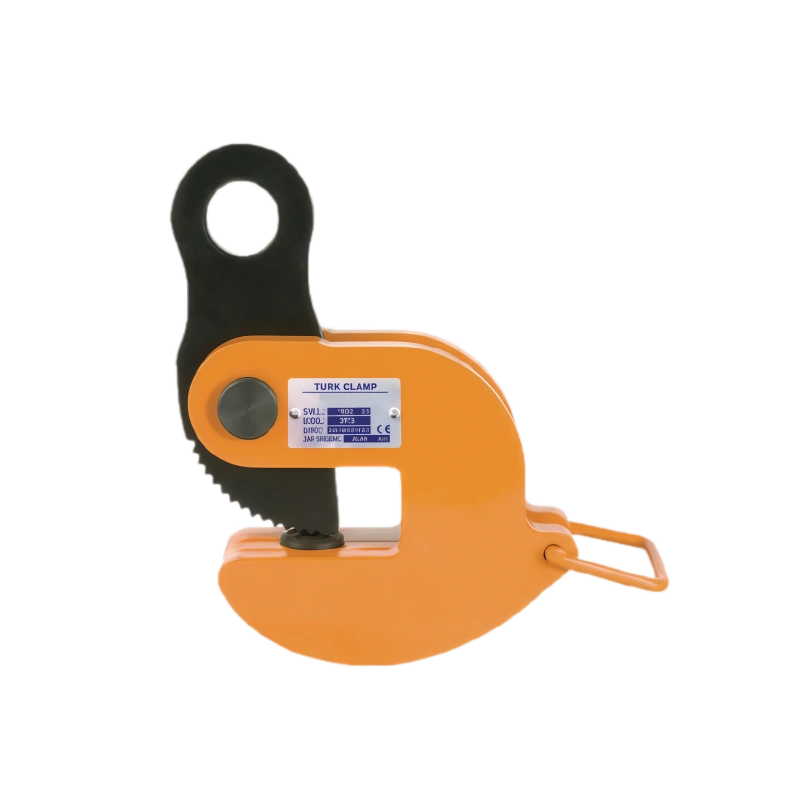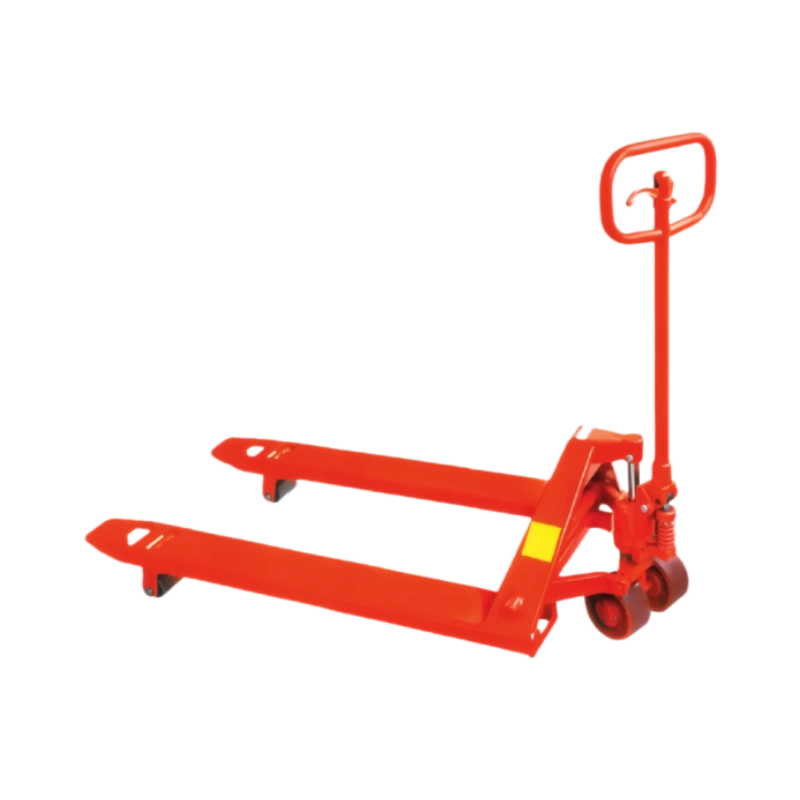DRAWING OF PLATE CLAMPS FOR LIFTING

SPECIFICATIONS of PLATE LIFTING CLAMPS
| Model | WLL (tons)per pair | Jaw Opening(mm) | Weight(kg) |
| DFQ1.5 | 1.5 | 0-20 | 4.9 |
| DFQ2.5 | 2.5 | 0-30 | 8.4 |
| DFQ5 | 5.0 | 0-40 | 16.9 |
| DFQ8 | 8.0 | 0-50 | 26 |
| DFQ10 | 10.0 | 0-60 | 35.8 |
| DFQ10 | 10.0 | 50-100 | 40 |
| DFQ20 | 20.0 | 50-100 | 76 |
LIFTING PLATE CLAMPS INFORMATION
-
Working Load Limit (WLL):
The clamp has a WLL ranging from 1.5T to 20T, making it suitable for lifting and flipping steel plates and profile steel. -
Usage:
-
Ideal for horizontal lifting and turning steel plates.
-
Can be used individually for lifting steel plates, with additional support required (e.g., a beam) for horizontal transport.
-
-
Design & Ease of Use:
-
Compact and lightweight design ensures easy handling and operation.
-
Simple to use with minimal setup and maintenance required.
-
-
Maximum Lifting Capacity:
-
The clamp can lift up to its rated load and can be used individually for lifting tasks.
-
For horizontal lifting, a beam must be added for better stability and balance.
-
INSTRUCTIONS & CAUTIONS
Suitable for Steel Plates with Specific Hardness
This turning plate lifting clamp is ideal for lifting and transporting steel plates with a maximum hardness of 37 HRc (345 HB, 1166 N/mm²). Before use, always check the hardness of the steel to make sure it falls within this range. Exceeding the clamp’s recommended hardness can damage the equipment or compromise safety.
Operating Conditions and Temperature Range
Our lifting clamps are designed to work in normal ambient conditions, with a temperature range of -40°C to +100°C. If your working environment falls outside this range, the clamp may lose its strength and performance. Always ensure the conditions are within these limits to maintain optimal safety and effectiveness.
Never Overload the Clamp
It’s essential not to overload the clamp. Always respect its rated working load limit (WLL) to avoid damaging the clamp or creating unsafe conditions. Overloading can result in accidents or failure of the lifting equipment, so always verify the weight before use.
Safety Precautions During Lifting
When lifting, always ensure that only one steel plate is lifted at a time. Make sure to use the full jaw depth for a secure grip. Maintain a safe distance while lifting or lowering the load, and never position anyone underneath the load. This will help ensure safe operations and prevent potential accidents.
OUR ADVANTAGES
Customizable to Your Needs
At Powerful Machinery, we don’t just sell standard solutions; we work with you to offer customized equipment that fits your unique requirements. Our team will assess your specific needs and provide tailored solutions that enhance your operations. From product modifications to personalized service, we ensure our equipment is a perfect match for your business.
High-Quality Standards and Reliability
We pride ourselves on the high standards of quality and reliability in our manufacturing process. Every product undergoes rigorous testing to ensure it meets the highest safety and performance criteria. By choosing us, you invest in equipment that stands up to the toughest jobs, giving you peace of mind that your business can rely on our products for the long term.
Reliable Customer Support
At Powerful Machinery, we provide exceptional customer support, available to assist you throughout the purchasing and after-sales process. Our dedicated team ensures quick responses to inquiries and offers expert guidance tailored to your specific needs. Whether you need help with product selection or troubleshooting, we're here to make your experience smooth and hassle-free.
Fast and Efficient Delivery
We understand that timely delivery is crucial for your operations. That’s why we prioritize fast and reliable shipping, ensuring your orders arrive when you need them. With our well-established logistics network, we guarantee that your lifting equipment will reach you on time, minimizing delays and ensuring you can maintain a seamless workflow in your projects.
FAQ
How do I select the right plate lifting clamp for my business?
Selecting the right plate lifting clamp depends on the weight and type of steel plates you’ll be handling. Ensure the clamp’s rated load limit (WLL) matches the weight of the plates. For horizontal, vertical, or turning lifts, we’ll guide you to the most suitable solution. Contact us for advice on the best clamp for your needs, based on your specific lifting requirements.
Are plate lifting clamps safe to use?
Yes, plate lifting clamps are built with safety in mind. They feature secure locking mechanisms to prevent accidental release of the load. To ensure maximum safety, always follow the manufacturer’s guidelines and avoid exceeding the clamp’s rated load. Our team is here to answer any safety-related questions and provide advice on proper use.
Can I lift more than one plate at a time with a plate lifting clamp?
It’s best to lift one plate at a time with a single clamp. For multi-plate lifts, use additional clamps or lifting beams for added stability. Overloading a single clamp can lead to dangerous situations. If you need equipment for handling multiple plates simultaneously, let us know, and we’ll recommend the right solutions.
How do I maintain a plate lifting clamp?
-
Regular Inspection: Inspect the clamp regularly for signs of wear or damage to ensure it operates safely and effectively.
-
Lubricate Moving Parts: Keep the moving components lubricated to ensure smooth operation and prevent unnecessary friction.
-
Check the Locking Mechanism: Always verify that the locking mechanism is secure before each use to avoid accidental release of the load.
-
Avoid Using Damaged Clamps: Never use a clamp that is damaged, as this can affect its performance and pose safety risks.
-
Need Help? Contact us for a detailed maintenance guide and expert advice to keep your equipment in top condition.
Are plate lifting clamps compatible with all steel plates?
Most plate lifting clamps are compatible with a wide range of steel plates. However, ensure the plate’s surface, weight, and hardness are within the clamp’s rated specifications. For example, clamps are generally suitable for plates up to 37 HRc in hardness. If your plates fall outside standard specifications, let us know—we can recommend the right clamp for your specific needs.
What should I do if the plate lifting clamp is damaged?
If your plate lifting clamp is damaged, stop using it immediately. Never use damaged equipment, as it can compromise safety. Contact our support team for advice on how to proceed, whether it’s repair, replacement, or part replacement. We’re happy to assist with getting your equipment back in working condition.
How do I order plate lifting clamps in bulk?
To place a bulk order, simply contact our sales team with the quantity and specifications you need. We offer competitive pricing for large orders, and we’ll assist with logistics to ensure timely delivery. Let us know your needs, and we’ll provide you with a seamless ordering experience.




